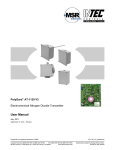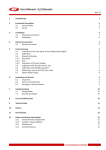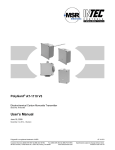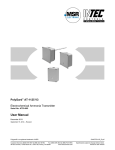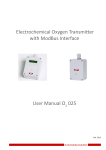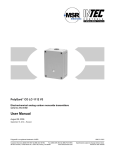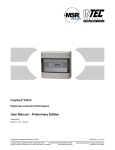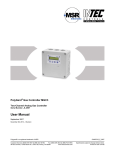Download User Manual - i+b controls
Transcript
PolyGard® ADT53-1120 and ADT63-1125 Electrochemical Ammonia Transmitter Serial No. AT03-003 User Manual April 2008 PolyGard® is a registered trademark of MSR Phone: 0049(0)8531/9004-0 Fax: 0049(0)8531/9004-54 MSR-Electronic-GmbH, Würdinger Str. 27, D 94060 Pocking GAADTX31125_E-0408 www:msr-electronic.de Specification subject to change without notice Made in Germany User Manual - PolyGard® NH3 ADT 53-1120 und ADT-63-1125 Page 2 1 Intended for Use....................................................................................................3 2 Functional Description .........................................................................................3 2.1 2.2 3 Mounting ................................................................................................................4 3.1 3.2 4 Calibration............................................................................................................................... 5 Manual Calibration.................................................................................................................. 6 Zero-point ............................................................................................................................ 6 Gain..................................................................................................................................... 6 Calculation of Control Voltage ............................................................................................ 6 Calibration with DGC-05 Service Tool.................................................................................... 7 Calibration with DGC-05 Configuration and Calibration Software.......................................... 7 Addressing, only for DGC-05_Bus Mode ............................................................................... 8 Option Relay Output ............................................................................................................... 8 Service and Inspection .........................................................................................9 6.1 6.2 6.3 7 Wiring Connection .................................................................................................................. 4 Commissioning .....................................................................................................5 5.1 5.2 5.2.1 5.2.2 5.2.3 5.3 5.4 5.5 5.6 6 Mounting Instructions.............................................................................................................. 4 Installation............................................................................................................................... 4 Electrical Connection ...........................................................................................4 4.1 5 Control Mode .......................................................................................................................... 3 Sensor..................................................................................................................................... 3 Inspections.............................................................................................................................. 9 Calibration............................................................................................................................... 9 Exchange of Sensor Element ................................................................................................. 9 Troubleshooting....................................................................................................9 7.1 7.2 Analog Mode........................................................................................................................... 9 DGC-05_Bus Mode .............................................................................................................. 10 8 Cross Sensivity Data ..........................................................................................10 9 Technical Data.....................................................................................................11 10 Figures .................................................................................................................13 11 Notes and General Information..........................................................................15 11.1 11.2 11.3 11.4 Intended Product Application................................................................................................ 15 Installers’ Responsibilities .................................................................................................... 15 Maintenance ......................................................................................................................... 15 Limited Warranty................................................................................................................... 15 PolyGard® is a registered trademark of MSR Phone: 0049(0)8531/9004-0 Fax: 0049(0)8531/9004-54 MSR-Electronic-GmbH, Würdinger Str. 27, D 94060 Pocking GAADTX31125_E-0408 www:msr-electronic.de Specification subject to change without notice Made in Germany User Manual - PolyGard® NH3 ADT 53-1120 und ADT-63-1125 Page 3 Electrochemical Ammonia Transmitter 1 Intended for Use The PolyGard® NH3 analog transmitter with digital processing of the measured values and temperature compensation is used to detect leakages of ammonia in the ambient air. The sites intended for use are all areas being directly connected to the public low voltage supply, e.g. domestic, commercial and industrial ranges as well as small enterprises (acc. to EN 50 082). The PolyGard® NH3 analog transmitter is not suitable for the application in areas exposed to explosive hazards. 2 Functional Description 2.1 Control Mode In addition to the analog output the transmitter is equipped with a serial interface RS-485 for the connection to the PolyGard® DGC-05 system. Analog mode: The analog output can be selected as current signal with (0)4-20 mA or as voltage signal (0)2-10 V. In the 4-20 mA mode and without any supplementary options, the ADTX3 also works in the 2-wire technique. DGC-05_Bus mode: The transmitter can be connected to the PolyGard® DGC-05 system via the RS-485 interface. In this mode there is an analog input for the connection of an additional 4-20 mA transmitter. The two measuring values are transmitted via the RS-485 interface to the gas controller. The cable topology for the RS-485 bus can be taken from the “Guidelines for wiring and commissioning of the DGC-05 hardware”. The two control modes are available in parallel. 2.2 Sensor The sensor portion of the transmitter is a sealed micro-fuel cell with three electrodes, sensing, counter and reference. The ambient air enters the cell through a diffusion barrier into the liquid electrolyte of the sensor. The chemical process of the measurement is one of reduction where one molecule of the target gas is exchanged for one molecule of oxygen. The reaction drives the oxygen molecule to the counter electrode, generating a DC microampere signal between the sensing and counter electrodes. This signal is linear to the volume concentration of the sensed gas. The signal is evaluated by the connected amplifier and transformed into a linear output signal. Electrochemical processes always lead by-and-by to a loss of sensitivity. Therefore regular calibration of the zero-point and of the gain is necessary. See also section 6. Caution: Avoid any force (e.g. by thumb) on the sensor element during operation or installation. This could destroy the sensor element. There is a small quantity of corrosive liquid in the sensor element. If in case of damage persons or objects encounter the liquid, you have to clean the affected areas as fast and carefully as possible with tap water. Out of use sensors must be disposed in the same way as batteries. PolyGard® is a registered trademark of MSR Phone: 0049(0)8531/9004-0 Fax: 0049(0)8531/9004-54 MSR-Electronic-GmbH, Würdinger Str. 27, D 94060 Pocking GAADTX31125_E-0408 www:msr-electronic.de Specification subject to change without notice Made in Germany User Manual - PolyGard® NH3 ADT 53-1120 und ADT-63-1125 Page 4 3 Mounting Caution: Electronics can be destroyed by static electricity. Therefore, do not touch the equipment without a wrist strap connected to ground or without standing on conductive floor. (acc. to DIN EN 100015). 3.1 Mounting Instructions When choosing the mounting site please pay attention to the following: • The specific weight of Ammonia, NH3, is lower than that of air (factor 0,59). • Installation at the highest point possible with a distance of ca. 300 mm to the ceiling. • Select the location of the sensor according to local regulations. • Consider the ventilation conditions! Do not mount the transmitter in the center of the airflow (air passages, suction holes) • Mount the transmitter at a location with minimum vibration and minimum variation in temperature (avoid direct sunlight). • Avoid locations where water, oil etc. may influence proper operation and where mechanical damage might be possible. • Provide adequate space for maintenance and calibration work. Duct mounting • Mount only in a straight section of duct with minimum air vortex. Keep a minimum distance of 1 m (3,5 feet) from any curve or obstacle. • Mount only in a duct system with a maximum air velocity of 10 m/s (2000 ft/min) or less. • Mounting must be performed so that the airflow is in line with probe openings. 3.2 Installation • Open cover of enclosure. Unplug PCB from terminal blocks. • Fix bottom part by screws vertically to the wall (terminal blocks to the ground). • Re-plug the PCB at X4 and X5. Replace the cover. 4 Electrical Connection Consider static electricity! See 3. Mounting. • Installation of the electrical wiring should only be performed by a trained specialist according to the connection diagram and according to the corresponding regulations, without any power applied to conductors! • Avoid any influence of external interference by using shielded cables. • Recommended cable for analog mode: J-Y(St)Y 2x2x0,8 LG (20 AWG), max. resistance 73 Ω/km (20.8 Ω/1000 ft). • Required cable for RS-485 mode: J-Y(St)Y 2x2x0,8 LG (20 AWG), max. res. 73 Ω/km (20.8 Ω/1000 ft) • When the PBC is mounted, it is important to ensure that the wire shields or any bare wires do not short the PCB. 4.1 Wiring Connection • Open cover of enclosure. Unplug PCB from terminal blocks X4 and X5. • Enter cable through hole; connect cable leads to the terminal blocks. See fig. 1 and 2. • Re-plug the basic PCB at the terminal blocks X4, X5. Close cover. PolyGard® is a registered trademark of MSR Phone: 0049(0)8531/9004-0 Fax: 0049(0)8531/9004-54 MSR-Electronic-GmbH, Würdinger Str. 27, D 94060 Pocking GAADTX31125_E-0408 www:msr-electronic.de Specification subject to change without notice Made in Germany User Manual - PolyGard® NH3 ADT 53-1120 und ADT-63-1125 Page 5 5 Commissioning Consider commissioning instructions at any exchange of sensor elements. Only trained technicians should perform the following: • Check mounting location. • Select output signal form: Current or voltage, and starting point 0 or 20%. See fig. 4. • Check supply voltage. • Check PCB AT03-003 for correct mounting at X4 and X5. • Check sensor element for correct mounting at terminal X3 of the PCB AT03-003. • Addressing of the transmitter in the DGC-05_Bus mode. • Calibration of the transmitter (if not factory-calibrated) Required instruments to calibrate the transmitter: • Test gas bottle with synthetic air • Test gas bottle with test gas NH3 in the range of 20 to 70 % of the measurement range • Gas pressure regulator with flow meter to control the gas flow to 300 ml/min • Sensor head calibration adapter with tube. Type calibration set AT1110CO1. See Fig. 5. • Digital voltmeter with range 0 – 2 VDC, accuracy 1%. • Screwdriver small. • Calibration tool DGC-05 STL (only for calibration with service tool DGC-05). • DGC-05 configuration and calibration software incl. USB/RS-485 communication set (only for software calibration mode). Note: Prior to calibration the sensor element must be fully stabilized by applying power voltage for at least 18 hours without interruption. Please observe proper handling procedures for test gas bottles according to TRGS 220! NH3 calibration gas is toxic, never inhale the gas! Symptoms at high concentrations: Loss of motility and consciousness. Procedure if exposed: Get the victim into fresh air at once, consult doctor. 5.1 Calibration Depending on the version and the control mode there are three different possibilities to calibrate the transmitter: Manual calibration Manual calibration is only possible if the transmitter is equipped with the push-button “Zero” and the potentiometer “Gain” (= version for manual calibration). Manual calibration is possible both in analog mode and in DGC-05_Bus mode. In the DGC-05_Bus mode the jumper V-A has to be set before manual calibration. Only by doing so the control voltage is available at the test pins X6. Remove the jumper after calibration Calibration with the Service Tool DGC-05 In the standard version (equipped with the communication connector X12) the transmitter is delivered for tool and/or software calibration. In the analog mode the service tool calibration is only possible with the 3-wire technique of the transmitter! In the DGC-05_Bus mode calibration is always possible. PolyGard® is a registered trademark of MSR Phone: 0049(0)8531/9004-0 Fax: 0049(0)8531/9004-54 MSR-Electronic-GmbH, Würdinger Str. 27, D 94060 Pocking GAADTX31125_E-0408 www:msr-electronic.de Specification subject to change without notice Made in Germany User Manual - PolyGard® NH3 ADT 53-1120 und ADT-63-1125 Page 6 Software calibration via PC In the standard version (equipped with the communication connector X12) calibration can also be done by means of the configuration and calibration software. Software calibration is possible for both control modes. 5.2 Manual Calibration 5.2.1 Zero-point • Connect the calibration adapter carefully to the sensor element. • Apply zero calibration gas, (0,3 l/min; 1 Bar ± 10%), or other clean air source to the sensor element. • Wait 3 minutes until the signal is about 40 mV and stable, then press the button Zero for 5 seconds. Finished! After successful calibration the measuring signal is corrected automatically. Depending on the selected signal starting point the measuring signal shows the following values: Signal start at 2 V or 4 mA 40 mV = 0 ppm Signal start at 0 V or 0 mA 0 mV = 0 ppm If the zero-point is out of the admissible range (> 20 mV at starting point 0% / > 60 mV at starting point 20%) before calibration, there is no correction of the measuring signal. The sensor has to be replaced. • Remove calibration adapter carefully by turning lightly. Inspect close seat of sensor element! 5.2.2 Gain • Connect calibration adapter carefully to the sensor element. • Apply test gas NH3 (20 to 70 % of the measurement range) to the sensor (0,3 l/min; 1 Bar ± 10%) • Wait 3 minutes until the sensor is stable, adjust signal with gain potentiometer ”Gain” until the signal corresponds to the appropriate mVDC ± 3 mV (see calculation control voltage 5.3) and is stable. • Remove calibration adapter with a careful light turn. Inspect the correct mounting of the sensor element. By limiting the gain factor, calibration will not be possible any more when the sensitivity of the sensor reaches a residual sensitivity of 30 %. Then the sensor has to be replaced. 5.2.3 Calculation of Control Voltage Control voltage (mV) = 160 (mV) x test gas concentration NH3 (ppm) measuring range NH3 (ppm) + 40 (mV) Example Measuring range NH3 300 ppm 1000 ppm Test gas concentration NH3 205 ppm 405 ppm Control voltage 149 mV 105 mV 160 (mV) x 205 (ppm) + 40 (mV) = 149 mV. 300 ppm PolyGard® is a registered trademark of MSR Phone: 0049(0)8531/9004-0 Fax: 0049(0)8531/9004-54 MSR-Electronic-GmbH, Würdinger Str. 27, D 94060 Pocking GAADTX31125_E-0408 www:msr-electronic.de Specification subject to change without notice Made in Germany User Manual - PolyGard® NH3 ADT 53-1120 und ADT-63-1125 5.3 Page 7 Calibration with DGC-05 Service Tool • Connect the DGC-05 Service Tool to the transmitter, open menu “Calibration”. • Enter measuring range and test gas concentration. • Connect calibration adapter carefully to the sensor element • Apply synthetic air (150 ml/min; 1 Bar (14.5 psi ) ± 10%), or NH3-free ambient air. • Wait until the measuring value is stable, and then perform automatic zero calibration. • Apply calibration test gas NH3 (20 to 70 % of the measurement range) to the sensor (0,3 l/min; 1 Bar ± 10%). • Wait until the measuring value is stable, and then perform automatic gain calibration. • Remove calibration adapter carefully by turning lightly. Check the sensor for correct mounting! By limiting the gain factor, calibration will not be possible any more when the sensitivity of the sensor reaches a residual sensitivity of 30 %. In this case the sensor has to be replaced. Further information can be taken from the user manual of the DGC-05 Service Tool. 5.4 Calibration with DGC-05 Configuration and Calibration Software • Connect the PC via USB/RS-485 communication set to the transmitter, open menu “Calibration”. • Enter measuring range and test gas concentration. • Connect calibration adapter carefully to the sensor element • Apply synthetic air (150 ml/min; 1 Bar (14.5 psi ) ± 10%), or NH3-free ambient air. • Wait until the measuring value is stable, and then perform automatic zero calibration. • Apply calibration test gas NH3 (20 to 70 % of the measurement range) to the sensor (0,3 l/min; 1 Bar ± 10%). • Wait until the measuring value is stable, and then perform automatic gain calibration. • Remove calibration adapter carefully by turning lightly. Check the sensor for correct mounting! By limiting the gain factor, calibration will not be possible any more when the sensitivity of the sensor reaches a residual sensitivity of 30 %. In this case the sensor has to be replaced. Further information can be taken from the user manual of the DGC-05 Configuration and Calibration Software. PolyGard® is a registered trademark of MSR Phone: 0049(0)8531/9004-0 Fax: 0049(0)8531/9004-54 MSR-Electronic-GmbH, Würdinger Str. 27, D 94060 Pocking GAADTX31125_E-0408 www:msr-electronic.de Specification subject to change without notice Made in Germany User Manual - PolyGard® NH3 ADT 53-1120 und ADT-63-1125 Page 8 5.5 Addressing, only for DGC-05_Bus Mode In the DGC-05_Bus mode each transmitter gets its communication address. In the standard version with the communication connector X12, addressing is done by means of the DGC-05 Service Tool or by the DGC-05 Configuration and Calibration Software. See user manual of the Service Tool or of the Configuration and Calibration Software. In the manual addressing version which can be identified by the address switch being equipped, there is a maximum of 60 addresses to be selected. See fig. 3. The jumper is responsible to define the address group and the switch to define the address according to the following table. Switch position 0 1 2 3 4 5 6 7 8 9 A B C D E F Jumper pos. 01 = address inactive 01 02 03 04 05 06 07 08 09 10 11 12 13 14 15 Jumper pos. 02 = address inactive 16 17 18 19 20 21 22 23 24 25 26 27 28 29 30 Jumper pos. 03 = address inactive 31 32 33 34 35 36 37 38 39 40 41 42 43 44 45 Jumper pos. 04 = address inactive 46 47 48 49 50 51 52 53 54 55 56 57 58 59 60 5.6 Option Relay Output The two relays are activated in dependence of the gas concentration. If the gas concentration exceeds the adjusted alarm threshold, the corresponding relay switches on. If the gas concentration falls below the threshold minus hysteresis, the relay switches off again. The contact function for relay 2, NC (normally closed) or NO (normally open), can be selected via the jumper NO/NC. See fig 1 and 3. Relay 1 is equipped with a change-over contact. Via the ModBus interface the two alarm thresholds and the hysteresis are freely adjustable at the PC within the measuring range. The procedure can be read from the user manual “ModBus Software”. The following parameters are factory-set. Alarm threshold 1 = Relay 1: 80 ppm Alarm threshold 2 = Relay 2: 250 ppm Switching hysteresis: 15 ppm PolyGard® is a registered trademark of MSR Phone: 0049(0)8531/9004-0 Fax: 0049(0)8531/9004-54 MSR-Electronic-GmbH, Würdinger Str. 27, D 94060 Pocking GAADTX31125_E-0408 www:msr-electronic.de Specification subject to change without notice Made in Germany User Manual - PolyGard® NH3 ADT 53-1120 und ADT-63-1125 Page 9 6 Service and Inspection 6.1 Inspections Inspection, service and calibration of the transmitters have to be done by trained technicians and executed at regular intervals. We therefore recommend to conclude a service contract with MSR or one of their authorized partners. 6.2 Calibration (See section 5.1 and 5.2) • At commissioning and at periodic intervals determined by the person responsible for the gas detection system (recommendation: every 6 months) • After exchange of the sensor • If in case of operational or climatic influences the sensitivity of the sensor falls below 30 % in operation, calibration will not be possible any more. Then the sensor has to be replaced. 6.3 Exchange of Sensor Element Consider static electricity! See point 3. Sensor should always be installed without voltage applied. • Unplug basic PCB AT03 carefully from the terminal blocks on base. • Unplug old sensor element from the PCB. • Take new sensor element out of original packing. • Plug in sensor element into the PCB AT03 at X3. • Plug in carefully the PCB AT03 into terminal block X4, X5. • Calibrate according to section 5. 7 Troubleshooting 7.1 Analog Mode Trouble Cause Solution Output signal < 3 mA / 1,5 V and/or control voltage < 30 mV only for starting signal 2V/4 mA Jumper 0-20 % not set Check jumper position Power voltage not applied Measure tension at X4: Two-wire: Pin 1 (+) and 4 (-) Three-wire: Pin 1 (+) and 2 (-) PCB AT03 not plugged in correctly at X4 and X5 Replug PCB correctly Output signal > 22 mA /220 mV Control voltage does not reach the calculated value Wire break Short-circuit Check the wiring Check the wiring Sensor element not calibrated Calibrate sensor element Sensor sensitivity < 30 % No reaction of the output signal in spite of gas concentration Power voltage not applied Signal (Pin 4) not wired correctly Replace sensor element Measure tension at X4 PolyGard® is a registered trademark of MSR Phone: 0049(0)8531/9004-0 Fax: 0049(0)8531/9004-54 MSR-Electronic-GmbH, Würdinger Str. 27, D 94060 Pocking Check the wiring GAADTX31125_E-0408 www:msr-electronic.de Specification subject to change without notice Made in Germany User Manual - PolyGard® NH3 ADT 53-1120 und ADT-63-1125 7.2 Page 10 DGC-05_Bus Mode Trouble Cause Solution Yellow LED not shining Power voltage not applied Measure tension at X4: Pin 1 (+) and 2 (-) PCB not plugged in correctly at X4/X5 Replug PCB correctly Yellow LED not flashing Wire break No communication at the transmitter Check wiring Transmitter not addressed, check bus wiring incl. topology and termination Voltage < 16 V No control voltage at calibration Jumper V-A not set Set the jumper. Remove it after calibration! 8 Cross Sensitivity Data The cross sensivity depends on the used transmitter type and can be read from the table Technical Data (see 9.). Other gases can have an influence on the sensivity, too. The table does not claim to be complete. The indicated sensivity data are only standard values referring to new sensor elements. PolyGard® is a registered trademark of MSR Phone: 0049(0)8531/9004-0 Fax: 0049(0)8531/9004-54 MSR-Electronic-GmbH, Würdinger Str. 27, D 94060 Pocking GAADTX31125_E-0408 www:msr-electronic.de Specification subject to change without notice Made in Germany User Manual - PolyGard® NH3 ADT 53-1120 und ADT-63-1125 Page 11 9 Technical Data General sensor performances Gas type Sensor element Measuring range Pressure range Humidity Storage temperature range Storage time Accuracy Repeatability Zero-point Long-term output drift Response time Temperature range Life expectancy Cross sensitivity* Carbon monoxide; CO Hydrogen H2 Sulphur dioxide SO2 Hydrogen sulphide H2S Nitrate monoxide NO Nitrogen dioxide NO2 Chlorine Cl2 Carbon dioxide CO2 Accuracy Repeatability Zero-point Long-term sensitivity output drift Response time Temperature range Life expectancy Cross sensitivity* Carbon monoxide; CO Hydrogen H2 Sulphur dioxide SO2 Hydrogen sulphide H2S Phosphates Nitrogen dioxide NO2 Chlorine Cl2 Hydrogen chloride HCl Carbon dioxide CO2 Alcohols Amines Arsines Ammonia (NH3) Electrochemical, diffusion 0 - 300 ppm / 0 - 1000 ppm Atmosphere ± 15 % 15 – 90 % RH non condensing 5 °C to 20 °C Max. 3 months Type AT-53-1120 4 ppm < 3 % of reading 0 ppm ± 16 ppm < 5% signal loss/6 months t90 < 35 sec. -10 °C to + 40 °C > 2 years/normal operating environment Concentration Reaction 300 ppm 0 ppm 200 ppm 0 ppm 20 ppm - 7 ppm 20 ppm 7 ppm 20 ppm - 1 ppm 20 ppm - 20 ppm 20 ppm - 55 ppm 2 % vol 0 ppm Type AT-63-1125 < 15 ppm < 5 % of reading 0 ppm ± 15 ppm < 10% signal loss/6 months t90 < 120 sec.; t50 < 20 sec. -40 °C to + 10 °C > 18 months/normal operating environment Concentration Reaction 100 ppm 95 ppm 3000 ppm 3000 ppm 20 ppm 5 ppm 20 ppm 40 ppm 300 ppm 0 ppm 10 ppm 0 ppm 5 ppm 0 ppm 10 ppm 0 ppm 0,5 % vol 0 ppm 1000 ppm yes --yes 0,2 ppm 0 ppm PolyGard® is a registered trademark of MSR Phone: 0049(0)8531/9004-0 Fax: 0049(0)8531/9004-54 MSR-Electronic-GmbH, Würdinger Str. 27, D 94060 Pocking GAADTX31125_E-0408 www:msr-electronic.de Specification subject to change without notice Made in Germany User Manual - PolyGard® NH3 ADT 53-1120 und ADT-63-1125 Electrical Power supply Power consumption (without options) Output signal Analog output signal Selectable: Current / tension Starting point 0 / 20 % Serial interface Transceiver Physical Enclosure* Enclosure colour* Dimensions* Weight* Protection class* Mounting* Cable entry Wire connection Wire distance Guidelines Warranty Page 12 18 - 28 VDC/AC, reverse polarity protected 22 mA, max. (0,6 VA) (0) 4 – 20 mA, load ≤ 500 Ω, (0) 2 - 10 V; load ≥ 50 k Ω proportional, overload and short-circuit proof RS 485 / 19200 Baud Stainless steel V2A Natural, brushed (B x H x T) ca. 113 x 135 x 45 mm Ca. 0,5 kg IP 55 Wall mounted, pillar mounted Standard 1 x M 20 Screw-type terminal min. 0,25, max. 2,5 mm2 Current signal ca. 500 m Voltage signal ca. 200 m EMC Directive 89/336/EEG CE 1 year on material (without sensor) Options Relay output Alarm relay 1 Alarm relay 2 Power consumption Warning buzzer Acoustic pressure Frequency Power consumption LCD-Display LCD Power consumption Heating Temperature controlled Ambient temperature Power supply Power consumption Analog input Only for RS-485 mode 30 VAC/DC 0,5 A, potential-free, SPDT 30 VAC/DC 0,5 A, potential-free SPNO/SPNC 30 mA, max. 0,8 VA) 85 dB (distance 300 mm) 3,5 kHz 30 mA, max. 0,8 VA) Two lines, 16 characters each, illuminated 10 mA, max. 0,3 VA) 3 °C ±2°C - 40 °C 18 - 28 VDC/AC 0,5 A; 12 VA 4 – 20 mA overload and short-circuit proof, input resistance 200 Ω PolyGard® is a registered trademark of MSR Phone: 0049(0)8531/9004-0 Fax: 0049(0)8531/9004-54 MSR-Electronic-GmbH, Würdinger Str. 27, D 94060 Pocking GAADTX31125_E-0408 www:msr-electronic.de Specification subject to change without notice Made in Germany User Manual - PolyGard® NH3 ADT 53-1120 und ADT-63-1125 Page 13 10 Figures Application: Analog mode Fig. 1 4-20 mA 24 VDC 0 VDC 7 Bus_B 6 Bus_A 1 5 4-20 mA_Inp 2 4 Analog_Out 3 3 24 VDC_Out 4 2 0 VDC 5 1 24 VDC X5 X4 Transmitter ADTX3 Two-wire connection - 4 - 20 mA output signal without Controller 4-20 mA 24 VDC 0 VDC Option 7 Bus_B Relay 6 Bus_A 1 5 4-20 mA_Inp R1 2 4 Analog_Out 3 3 24 VDC_Out 4 2 0 VDC 5 1 24 VDC R2 X5 X4 Transmitter ADTX3 NO NC Controller Three-wire connection - VDC output signal - 0 – 20 mA output signal - Relay output - LCD display - Heating options Application: DGC-05_Bus mode Fig. 2 Option 7 Bus_B Relay 6 Bus_A 1 5 4-20 mA_Inp R1 2 4 Analog_Out 3 3 24 VDC_Out 4 2 0 VDC 5 1 24 VDC R2 X4 X5 Transmitter ADTX3 NO NC Analog Transmitter 4-20 mA 0 VDC 24 VDC 24 VDC 0 VDC Bus_A Bus_B NO NC Option 7 Bus_B Relay 6 Bus_A 1 5 4-20 mA_Inp R1 2 4 Analog_Out 3 3 24 VDC_Out 4 2 0 VDC 5 1 24 VDC R2 X4 X5 Transmitter ADTX3 Connection field bus and tension Connection analog transmitter - Two- or three-wire connection, depending on transmitter type PolyGard® is a registered trademark of MSR Phone: 0049(0)8531/9004-0 Fax: 0049(0)8531/9004-54 MSR-Electronic-GmbH, Würdinger Str. 27, D 94060 Pocking GAADTX31125_E-0408 www:msr-electronic.de Specification subject to change without notice Made in Germany User Manual - PolyGard® NH3 ADT 53-1120 und ADT-63-1125 Page PCB AT03 Fig. 3 14 Terminal block Option Manual Addressing V-A 2 1 Sensor XA3-1 XA3-2 X4 Anal. Output = V DC = mA ATX3_003 = NO = NC 1 2 3 4 5 1 2 3 4 5 6 7 X5 NO/NC 3 Function Relay R2 Test Zero NO NC 5 0-20% X5 Option Relay R2 R1 Connector Service Tool 6 X4 1 2 3 4 5 7 4 Anal. Output Start Point = 20 % =0% Option Manual Calibration Gain Position 4 3 2 1 Selection analog output signal Fig. 4 Jumper 0- 20 % Jumper V-A Output signal Not set Not set 0 – 20 mA Set Not set 4 – 20 mA Not set Set 0 – 10 V Set Set 2 – 10 V Calibration adapter Fig. 5 Type: Calibr-set AT 1110CO1 PolyGard® is a registered trademark of MSR Phone: 0049(0)8531/9004-0 Fax: 0049(0)8531/9004-54 MSR-Electronic-GmbH, Würdinger Str. 27, D 94060 Pocking GAADTX31125_E-0408 www:msr-electronic.de Specification subject to change without notice Made in Germany User Manual - PolyGard® NH3 ADT 53-1120 und ADT-63-1125 Page 15 11 Notes and General Information It is important to read this user manual thoroughly and clearly in order to understand the information and instructions. The PolyGard® transmitters must be used within product specification capabilities. The appropriate operating and maintenance instructions and recommendations must be strictly followed. Due to ongoing product development, MSR reserves the right to change specifications without notice. The information contained herein is based upon data considered to be accurate. However, no guarantee is expressed or implied regarding the accuracy of these data. 11.1 Intended Product Application The PolyGard® NH3 transmitters are designed and manufactured for control applications and air quality compliance in commercial buildings and manufacturing plants. 11.2 Installers’ Responsibilities It is the installer’s responsibility to ensure that all PolyGard® transmitters are installed in compliance with all national and local codes and OSHA requirements. Installation should be implemented only by technicians familiar with proper installation techniques and with codes, standards and proper safety procedures for control installations and the latest edition of the National Electrical Code (ANSI/NFPA70). It is also essential to follow strictly all instructions as provided in the user manual. 11.3 Maintenance It is recommended to check the PolyGard® transmitter regularly. Due to regular maintenance any deterioration of performance may easily be corrected. Re-calibration and part replacement may be implemented in the field by a qualified technician and with the appropriate tools. Alternatively, the easily removable plug-in transmitter card with the sensor may be returned for service to MSR-Electronic-GmbH. 11.4 Limited Warranty MSR-Electronic-GmbH warrants the PolyGard® transmitters for a period of one (1) year from the date of shipment against defects in material or workmanship. Should any evidence of defects in material or workmanship occur during the warranty period, MSR-Electronic-GmbH will repair or replace the product at their own discretion, without charge. This warranty does not apply to units that have been altered, had attempted repair, or been subject to abuse, accidental or otherwise. The warranty also does not apply to units in which the sensor element has been overexposed or gas poisoned. The above warranty is in lieu of all other express warranties, obligations or liabilities. This warranty applies only to the PolyGard® transmitters. MSR-Electronic-GmbH shall not be liable for any incidental or consequential damages arising out of or related to the use of the PolyGard® transmitters. PolyGard® is a registered trademark of MSR Phone: 0049(0)8531/9004-0 Fax: 0049(0)8531/9004-54 MSR-Electronic-GmbH, Würdinger Str. 27, D 94060 Pocking GAADTX31125_E-0408 www:msr-electronic.de Specification subject to change without notice Made in Germany















